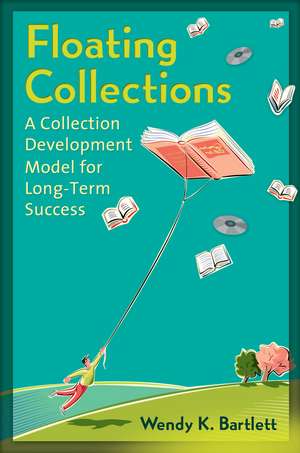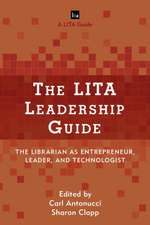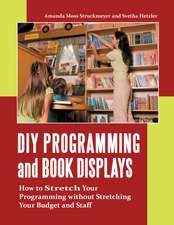Floating Collections: A Collection Development Model for Long-Term Success
Autor Wendy K. Bartletten Limba Engleză Paperback – 12 ian 2014 – vârsta până la 17 ani
Preț: 316.74 lei
Preț vechi: 450.82 lei
-30% Nou
Puncte Express: 475
Preț estimativ în valută:
60.61€ • 63.45$ • 50.15£
60.61€ • 63.45$ • 50.15£
Carte tipărită la comandă
Livrare economică 05-19 aprilie
Preluare comenzi: 021 569.72.76
Specificații
ISBN-13: 9781598847437
ISBN-10: 1598847430
Pagini: 152
Dimensiuni: 156 x 235 x 10 mm
Greutate: 0.27 kg
Editura: Bloomsbury Publishing
Colecția Libraries Unlimited
Locul publicării:New York, United States
ISBN-10: 1598847430
Pagini: 152
Dimensiuni: 156 x 235 x 10 mm
Greutate: 0.27 kg
Editura: Bloomsbury Publishing
Colecția Libraries Unlimited
Locul publicării:New York, United States
Caracteristici
A bibliography of publications on floating collections, covering websites of floating libraries, PLA presentations, articles, and listserv archives
Notă biografică
Wendy K. Bartlett, MLIS, is collection development manager for the Cuyahoga County Public Library, Parma, OH.
Cuprins
AcknowledgmentsIntroduction to Floating CollectionsWhy Floating Works for Today's LibrariesA Word about eBooksIt Is Not All About the MoneyWhy a Book on Floating Collections?OrganizationMethodologyCommon Concerns That Are AddressedChapter One: The History of Floating CollectionsFloating CollectionsHow the Float Behaves-and MisbehavesThe Advantages and Disadvantages of a Floating CollectionWho Floats, Who Does Not, and WhyHas Anyone Ever Quit Floating?Is Floating Right for Your Library System?Chapter Two: Deciding Whether or Not to Float the CollectionSteering a Middle CourseHow Will Floating Affect the Patrons?How Will Floating Affect Circulation?How Will Floating Affect the Staff?How Will Floating Affect the Collection?How Will Floating Affect Fellow Consortia Libraries?Are There Other Mind-Bending, Paradigm-Shifting, Major Upheavals Taking Place?Have Like Libraries Converted Successfully to Floating?What Are the Hidden Costs or Risks?Is Now the Right Time to Centralize?What Is the Worst-Case Scenario?Whom to InvolveDeciding to Float: Discussion QuestionsChapter Three: Prediction and PreparationBranch Size and Circulation RankMeasuring Patron BehaviorPredicting SuccessCalculating the Prefloat PercentageTracking the Invisible Patron: Floating and the Hold ShelfLocation, Location, LocationHeed the WeedInterpreting ResultsChapter Four: Communication: Preparing the StaffStaff MoraleManaging the ChangeStaff Concerns before the FloatPlanning Staff CommunicationBranch VisitsRebalancing Work GroupPostfloat Staff ConcernsChapter Five: Preparing the Collection to FloatWhat Should NOT FloatThe High Cost of Bad Shelving PracticesThe 24-Door-to-Floor Shelving MethodThe Big WeedChapter Six: Implementation and Postfloat ConsiderationsImplementation and Postfloat CommunicationPostfloat Branch VisitsThe Postfloat PercentageRebalancingThe Float Is Right; the Shelves Are WrongChapter Seven: Managing a Floating Collection in the Long TermSelecting and Budgeting for a Floating CollectionThe Importance of Branch Visits for SelectorsFloating and CirculationPatron Behavior, Not Staff OpinionCore Collection and WeedingVetting Old Editions in a Floating CollectionWeeding a Floating CollectionEpilogue: Floating and the User ExperienceFloating and the User ExperienceCollection Work and the User ExperienceFacility Planning and Design and the User ExperienceReaders' Advisory, Merchandising/Displays, Programming and the User ExperienceConclusionAppendix A: 10 Great Reasons to FloatAppendix B: Partial List of Floating LibrariesAppendix C: Floating Risk EvaluationAppendix D: Deciding to FloatAppendix E: Chart for Prefloat Branch VisitsAppendix F: Staff CommunicationAppendix G: Communication TimelineAppendix H: Sample 24-Door-to-Floor Cart TagBibliographyIndex
Recenzii
[Barrett] argues that floating is a service to communities, is fiscally responsible for budget-strapped systems, and, in the end, a benefit to library staff. Chapters include tips on how to approach the practice with staff, how to ready facilities and collections, and, most importantly, how to manage new collections. Also offered are practical evaluations, FAQs, and a list of larger systems in the United States that offer floating collections.
With many libraries exploring floating collections, Bartlett's book is a useful primer on the process and should be on the reading list for any library looking at floating.
Bartlett, collection development manager for the Cuyahoga County (Ohio) Public Library, begins this book with an introduction that discusses the basics of floating collections-what they are, how they are organized, their methodology, and which concerns such collections address. . . . Eight appendixes offer additional visuals to help librarians and administrators in the decision-making process and the managing of a floating collection.
This is a superb guide that tackles a challenging decision facing libraries. . . a useful manual to ease the most discerning librarian or administrator who may not be convinced that floating their collection is the best way to go. . . . Floating Collections is an excellent resource to have in your personal and library collection. . . . If your library is debating implementing a floating collection, this is the book for you.
Bartlett has written the guide on how to float and live to tell the tale. She provides ample guidance for answering staff questions and helping libraries determine whether floating would be a positive initiative financially and for patron service. I recommend this book for large public libraries as well as academic libraries to whom floating appeals.
With many libraries exploring floating collections, Bartlett's book is a useful primer on the process and should be on the reading list for any library looking at floating.
Bartlett, collection development manager for the Cuyahoga County (Ohio) Public Library, begins this book with an introduction that discusses the basics of floating collections-what they are, how they are organized, their methodology, and which concerns such collections address. . . . Eight appendixes offer additional visuals to help librarians and administrators in the decision-making process and the managing of a floating collection.
This is a superb guide that tackles a challenging decision facing libraries. . . a useful manual to ease the most discerning librarian or administrator who may not be convinced that floating their collection is the best way to go. . . . Floating Collections is an excellent resource to have in your personal and library collection. . . . If your library is debating implementing a floating collection, this is the book for you.
Bartlett has written the guide on how to float and live to tell the tale. She provides ample guidance for answering staff questions and helping libraries determine whether floating would be a positive initiative financially and for patron service. I recommend this book for large public libraries as well as academic libraries to whom floating appeals.






















